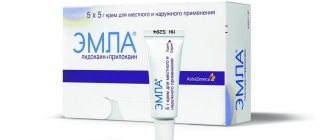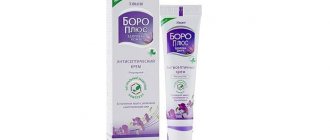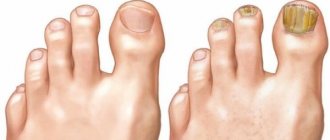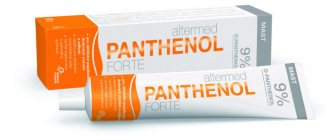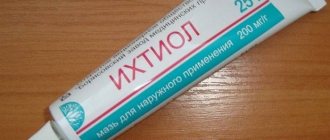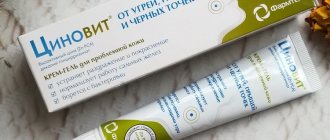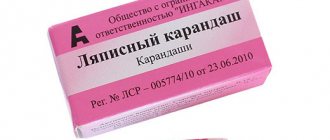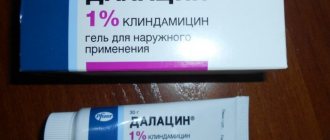Pharmacological properties of the drug Emla
EMLA cream contains lidocaine and prilocaine, amide-type local anesthetics. Due to the penetration of lidocaine and prilocaine into the layers of the epidermis and dermis, skin anesthesia occurs. The degree of anesthesia depends on the time of application and dose. Intact skin When EMLA cream is applied to intact skin for 1–2 hours, anesthesia lasts about 2 hours after removing the occlusive sticker. There were no differences in efficacy (including time to achieve analgesic effect) and safety when applied to intact skin between young and elderly patients. Due to the effect of the cream on the superficial vessels, temporary pallor or redness of the skin area is possible. Vasomotor reactions develop faster (already 30–60 minutes after applying the cream) in patients with widespread neurodermatitis (atopic neurodermatitis), which indicates a faster penetration of the cream through the changed skin. During a puncture biopsy (up to 4 mm in diameter), the use of the cream provides adequate anesthesia of intact skin in 90% of patients 60 minutes after applying the cream when the needle is inserted into the skin to a depth of 2 mm and after 120 minutes - to a depth of 3 mm. The effectiveness of the cream does not depend on the color and pigmentation of the skin (skin types I–IV). The cream can be used for pain relief before vaccination when administering the vaccine subcutaneously or intramuscularly. Genital mucosa The anesthetic effect of the mucous membrane appears earlier, since absorption occurs faster than in cases of application to intact skin. In women, after applying EMLA cream to the mucous membrane of the genital organs, after 5–10 minutes an analgesic effect is achieved that is sufficient for manipulations using an argon laser. The duration of anesthesia is 15–20 minutes (taking into account individual characteristics - from 5 to 45 minutes). Trophic ulcers of the lower extremities After applying the cream when treating trophic ulcers of the lower extremities, the duration of the analgesic effect is about 4 hours. The cream does not have a negative effect on the wound healing process and bacterial flora. Systemic absorption depends on the amount of cream, duration of application, skin thickness (which varies in different areas of the body) and other skin characteristics. Intact skin In adults, after applying 60 g of EMLA cream to 400 cm2 of intact skin on the thigh (1.5 g per 10 cm2) over 3 hours, systemic absorption was 3% for lidocaine and 5% for prilocaine. Absorption occurs slowly. At the above dose, the maximum plasma concentration of lidocaine (average 0.12 mcg/ml) and prilocaine (average 0.07 mcg/ml) was achieved approximately 4 hours after application. The risk of developing toxic symptoms exists only at doses of 5–10 mcg/ml. Trophic ulcers of the lower extremities After applying 5–10 g of EMLA cream to trophic ulcers with an exposure of 30 minutes, the maximum levels of lidocaine and prilocaine in the blood plasma were achieved after 1–2.5 hours (lidocaine concentration in the range of 0.05–0.84 μg/ml , prilocaine - 0.02–0.08 mcg/ml). After repeated application of EMLA cream to trophic ulcers, no significant accumulation of lidocaine, prilocaine or their metabolites in the blood plasma was noted (EMLA cream was applied at a dose of 2–10 g for 30–60 min to an area of 62 cm2 15 times a month for 3–7 sessions per week). Genital mucosa The maximum plasma concentration is achieved approximately 35 minutes after applying 10 g of EMLA cream to the vaginal mucosa with an exposure of 10 minutes (the average concentration of lidocaine was 0.18 mcg/ml; prilocaine - 0.15 mcg/ml) .
Contraindications
A contraindication to the use of Emla may be the presence of methemoglobinemia and the body’s reaction to its components. If you follow all the recommendations specified in the instructions, an overdose is unlikely. It should be noted that many users, leaving their reviews of the anesthetic, talk about complete anesthesia and advise using this particular option for depilation.
In case of allergic reactions to the components of the drug, it is always possible to find a replacement in the form of other painkillers. These may be: “Menovazin”, “Anestezol”, “Dentinox”, “Kamistad” and others.
A contraindication to the use of Emla may be the presence of methemoglobinemia and the body’s reaction to its components.
When removing unnecessary vegetation, Emla patches are also used. The disadvantage of this option is that the patches are small in size. And if you consider that only 3 pieces can be used at a time, then the scope of its application is significantly narrowed. They are mainly used in small and most painful areas: the armpit and bikini area. Reviews from those who have used Emla are mostly positive. The anesthesia is obvious, and the result lasts long enough to remove the vegetation.
Use of Emla
Adults:
Intact skin | Dose and Application | Duration of application |
| When inserting needles, for example to catheterize blood vessels or take blood samples | Tube volume (about 2 g) per 10 cm2. Apply a thick layer of cream to the skin and cover with an occlusive sticker | 1 hour; maximum 5 hours |
| For minor surgical procedures on the surface of the skin, such as the removal of warts | 1.5–2 g per 10 cm2. Apply a thick layer of cream to the skin and cover with an occlusive sticker | 1 hour; maximum 5 hours |
| When performing surgical procedures on large areas of the skin surface, such as split-flap skin harvesting | 1.5–2 g per 10 cm2. Apply a thick layer of cream to the skin and cover with an occlusive sticker | 2 hours; maximum 5 hours |
Trophic ulcers of the lower extremities During surgical treatment (mechanical cleansing) of trophic ulcers, apply 1–2 g of cream per 10 cm2 of surface. The cream is applied in a thick layer to the surface of the ulcer, no more than 10 g of cream per procedure. Cover the surface of the ulcer with an occlusive sticker. Duration of cream application is 30 minutes. The open tube is intended for one-time use; after each procedure, the unused cream is thrown away. When treating ulcers into which tissue penetration of the drug is difficult, the duration of application can be increased to 60 minutes. Surgical treatment of the wound surface should begin no later than 10 minutes after removing the cream. In the treatment of trophic ulcers of the lower extremities, EMLA cream is used up to 15 times over 1–2 months without reducing effectiveness or increasing the incidence of local reactions. Superficial anesthesia of the genital organs Skin of the genital organs Application of local anesthetics before injection:
- men: 1 g per 10 cm2. A thick layer of cream is applied to the skin. Duration of application - 15 minutes;
- women: 1–2 g per 10 cm2. A thick layer of cream is applied to the skin. Duration of application - 60 minutes.
Mucous membrane of the genital organs To remove condylomas or before injection of local anesthetics: 5–10 g of cream, depending on the area of treatment, is applied to the entire surface, including the folds of the mucous membrane. No occlusal adhesive is required. Application duration is 5–10 minutes. The surgical procedure should begin immediately after removing the cream. Children When performing percutaneous injections, removal of molluscum contagiosum and other superficial surgical manipulations: the dose of EMLA cream should not exceed 1 g per 10 cm2 of surface, the cream is applied in a thick layer to the surface of the skin and covered with an occlusive sticker.
Age | Application area | Duration of application |
| 0–3 months | Maximum 10 cm2 (total 1 g) (maximum daily dose) | 1 hour (note: no longer) |
| 3–12 months | Maximum 20 cm2 (total 2 g) | 1 hour |
| 1 year–6 years | Maximum 100 cm2 (total 10 g) | 1 hour; maximum 5 hours |
| 6–12 years | Maximum 200 cm2 (total 20 g) | 1 hour; maximum 5 hours |
Children with atopic dermatitis need to reduce the duration of application to 30 minutes. Recommendations regarding the method of use Pierce the sealed membrane of the tube with a spike located in the upper outer part of the lid. Squeeze out the required amount of cream and apply to the procedure site. When anesthetizing the skin, occlusive stickers are used, included in the kit with the cream (12 pieces, size 6x7 cm).
Are there any analogues
Emla cream is quite expensive, so if it is not suitable for this or another reason, you can choose cheaper analogues that have a similar mechanism of action.
Lidocaine spray effectively helps to numb areas of the skin. It is well tolerated and causes virtually no adverse reactions.
For anesthesia, simply spray a small amount of the product onto the desired area. The onset of anesthesia is noted after 1-3 minutes and lasts no more than an hour.
Reference! Emla cream has an analgesic effect after the procedure. When using Lidocaine spray, there may be discomfort after hair removal.
Another drug similar in mechanism of action is Light Dep cream. The main active substance is anestoderm, which has a faster effect and is less toxic compared to lidocaine. Anesthesia in the bikini area is noted after 15-20 minutes.
Side effects of Emla
True adverse reactions caused by the use of local anesthetics occur with a frequency of 1/1000 patients.
Often (1/100) | Skin: temporary local skin reactions at the application site, such as local blanching, redness, swelling |
Uncommon (1/100–1/1000) | Skin: after application, slight pain, itching (at the application site) |
Rarely (≤1/1000) | General: allergic reactions, in the most severe cases anaphylactic shock. Methemoglobinemia in children |
Isolated cases of local reactions at the site of application of the cream, such as hemorrhagic rashes or petechiae, have been reported, especially after prolonged application in children with atopic dermatitis or warts. If the drug accidentally gets into the eyes, corneal irritation may occur.
Precautionary measures
To ensure that the hair removal or depilation process is painless and that no side effects occur after using Emla, certain precautions must be observed.
When applying an anesthetic to the skin of the face, you need to ensure that the cream does not get on the mucous membrane of the eyes, since Emla causes irritation of the cornea. If accidental contact with the drug does occur, the eyes should be thoroughly rinsed with running water.
The use of cream for anesthesia of the upper lip should also be careful, since getting the product into the oral cavity is undesirable.
To avoid any unpleasant moments when using Emla before hair removal or depilation, experts advise studying the instructions for the drug and strictly following the instructions.
Special instructions for the use of Emla
Patients with glucose-6-phosphate dehydrogenase deficiency, congenital or idiopathic methemoglobinemia are more likely to develop drug-dependent methemoglobinemia. EMLA cream should be used with caution on the skin in the eye area, since the drug irritates the mucous membrane of the eyes. In addition, loss of protective reflexes due to anesthetic contact with the cornea can lead to irritation and damage to the cornea. If EMLA cream gets into your eyes, they should be immediately rinsed with water or saline (sodium chloride solution) and protected until sensitivity of the cornea is restored. In patients with atopic dermatitis, the cream should be used with caution, and the duration of application should be reduced to 15–30 minutes. The effectiveness of using the cream in newborns when taking blood from the heel has not been established. The safety and effectiveness of the drug in children under 3 months of age have been studied only using a single dose. In such children, after applying the cream, a temporary increase in the level of methemoglobin in the blood is often observed, lasting up to 13 hours. However, this fact is probably not clinically significant. The cream should not be applied to a damaged eardrum and should not be used in situations where the drug may penetrate into the middle ear cavity. The cream should not be applied to open wounds. The drug should not be applied to the genital mucosa in children due to insufficient data regarding absorption. At concentrations exceeding 0.5–2.0%, lidocaine and prilocaine exhibit bactericidal and antiviral properties. Therefore, if the drug is used during vaccination (intradermal administration of a live vaccine, for example BCG), careful monitoring of the results of vaccination is necessary. EMLA cream should not be used in children aged 0 to 12 months receiving concomitant therapy with drugs that induce methemoglobinemia due to the lack of sufficient clinical experience with its use. It is necessary to monitor patients receiving antiarrhythmic drugs belonging to class III (for example, amiodarone), taking into account the results of the ECG in such patients, since lidocaine and class III antiarrhythmic drugs have additive effects. Pregnancy and lactation period Data regarding treatment of pregnant women with EMLA cream are insufficient. The results of studies conducted on animals do not contain sufficiently complete and reliable information regarding the effect on pregnancy, embryonic/fetal development, childbirth and development after birth. Lidocaine and prilocaine penetrate the placental barrier and can be absorbed by fetal tissues. There were no reports of reproductive disturbances, such as an increased incidence of malformations or direct or indirect effects on the fetus. However, when using the drug during pregnancy, it is necessary to weigh the benefit/risk ratio. Lidocaine and, probably, prilocaine pass into breast milk, but in such small quantities that the effect of therapeutic doses of the drug on the child is unlikely. Does not affect the ability to drive vehicles and operate machinery.
Consumer Reviews
I decided to get laser hair removal this spring. I asked my girlfriends who did it whether it hurt or not. It's different for everyone. Some people are in pain, others are completely tolerable. In general, it all depends on the pain threshold. As far as I know, my pain threshold is average. I can bear it. This is what happened when I had epilation on my legs, everything was quite tolerable. I know that the skin in the bikini area is quite sensitive, and I immediately decided that when I did hair removal in the bikini area, I would definitely take pain relief. Pain relief with Emla cream. Everything is fine, but why is it so expensive? In my opinion, the price is absolutely unjustified. And based on the effect, I will say that the cream works and relieves pain quite well. At least I felt almost no pain.
Inna
https://www.medcentre.com.ua/medicamenty/emla-krem.html
Unfortunately, in my case, hair removal with Emla is still painful for me. Yes, there is numbness of the skin and the sensations have decreased by 5-10%, which is why I give the cream 2, not 1 out of 5. But otherwise, for me it was a waste of money, and with hot hair removal it’s just torture with a hot iron. It's a pity!
Merag
https://irecommend.ru/content/obezbolivayushchee-pri-epilyatsii-sovety-i-oshibki-mechta-stala-yavyu-kak-ne-tak-pobochka-ch
First, I spread Emla cream on one half of the bikini area and put a film on top so that it fits tightly to the smeared area. After an hour of waiting, I removed the film, wiped off the remaining cream and began the execution. For about five minutes I still gathered my courage, because my first experience of hair removal was very clearly remembered in my memory. Gathering my thoughts, I pulled back a piece of pasta and... I didn’t feel ANYTHING, absolutely nothing! She looked down: no hair, no pain, how could this be?
LetoNo4i
https://irecommend.ru/content/blagodarya-kremu-emla-teper-mozhno-delat-epilyatsiyu-sovershenno-bezboleznenno-sposob-primen
My first impressions of Emla were negative. I go to a cosmetologist for laser treatments, she always applied Emla to me in a thick layer under a film for 30 minutes, but the effect was only a couple of times out of dozens. Recently, prices at the salon went up, and she advised me to apply it myself in advance, which completely changed the effectiveness in a positive way. I also apply it under film before leaving the house. It turns out that I wait 2 hours before the procedure. Sometimes the treated area even turned red, and when it started to go numb, I always felt a slight burning sensation. By the time of the procedure, the surface of the skin is always completely numb. With this approach, the difference is very big. Even when the cosmetologist said that she was trying an even stronger and more painful regimen, the difference was not felt.
nataliaelisabeth
https://irecommend.ru/content/podruzhilas-s-nei-ne-srazu-0
Emla cream effectively anesthetizes the skin before depilation. The product has a small number of contraindications. To achieve the expected result, you should follow the recommendations for proper application and exposure of the drug.
- Author: woman
Rate this article:
- 5
- 4
- 3
- 2
- 1
(1 vote, average: 5 out of 5)
Share with your friends!
Emla drug interactions
EMLA cream may increase the formation of methemoglobin in patients receiving treatment with methemoglobin-inducing drugs (eg, sulfonamides). When using EMLA cream in high doses in patients receiving local anesthetics or drugs structurally similar to local anesthetics, such as tocainide, the risk of systemic additive effects must be considered. Specific studies of the interaction of the drug with local anesthetics and antiarrhythmic drugs belonging to class III have not been conducted, so caution is recommended when using them together.
Where can I buy the cream, its price
This ointment is truly a salvation for women who decide to undergo cosmetic injections and other beauty procedures.
Therefore, it is logical that many are wondering how much Emla costs and where it can be purchased. Everything is very simple - the drug is sold in almost any pharmacy in a package that contains 5 tubes of 5 grams of ointment. Some retail chains also sell tubes individually. Considering that for a cosmetic procedure like hair removal you will need at least 10-15 grams of ointment, it makes sense to buy a whole package. Emla ointment, the price of which starts from 300 rubles per 5 grams, is a fairly expensive product. But its effectiveness has been confirmed by not a single thousand patients and clients of beauty salons, who can now safely perform injections and other procedures completely painlessly. Note that in Russia the drug is most often sold in a concentration of 5%, while in the West there are products that contain almost twice as many active substances - 9%. Also, the manufacturer, the Swedish company “Recip Karlskoga AB”, produces the product in 30 gram tubes, as well as in the form of patches.
By the way, Emla ointment, the price of which in Russia is indicated above, costs almost half as much abroad - about 170 rubles for a 5-gram package. Therefore, if you often use this product, it makes sense to buy it during tourist trips or business trips abroad, or order it on English-language websites on the Internet.
Emla drug overdose, symptoms and treatment
If the recommended dosage regimen is followed, the development of systemic toxicity is unlikely. The probable symptoms of intoxication are the same as with the use of other local anesthetics: at the beginning, stimulation of the central nervous system, in severe cases, depression of the central nervous system and cardiac activity. Cases of clinically significant methemoglobinemia have been very rarely reported in children, as prilocaine in high doses can increase methemoglobin levels. Superficial application of 125 mg of prilocaine for 5 hours caused the development of moderate methemoglobinemia in a three-month-old child. Topical application of 8.6–17.2 mg/kg lidocaine led to the development of severe intoxication in infants. Severe neurological symptoms (convulsions, central nervous system depression) require symptomatic treatment: the use of mechanical ventilation and anticonvulsants. The antidote for methemoglobinemia is methylthionine. Due to the slow systemic absorption of the drug, the patient's condition must be monitored for several hours after the symptoms of intoxication have resolved.
Emla cream: reviews from those who did not like the product or did not like it (negative)
So, here are the negative points buyers highlight when characterizing the drug “Emla”:
- Firstly, almost everyone mentioned that the product is very expensive. And for procedures like hair removal, mesotherapy or for pain relief during surgical interventions, you need quite a lot of it, several tubes.
- For some, Emla ointment does not work at all, or its effect is not enough for complete pain relief. Perhaps this effect is obtained by those who apply the cream incorrectly. Or, given that the drug is very popular, it is possible that the buyer purchased a counterfeit or an expired tube.
- Many people get tired of waiting for the moment when the cream takes effect - after all, sometimes a whole hour must pass after application for the skin to be completely pain-free.
- It is also noted that 20-30 minutes after the peak of pain relief, the effect of the cream fades away - the unpleasant sensations reappear. Perhaps this is due to the individual characteristics of the body.
One way or another, there is only a very small percentage of those who are truly dissatisfied with the product, and for whom it simply does not work. The rest (cursing its high price) still recommend the drug “Emla” for use.
Doctors' opinions about the cream
Since Emla ointment is widely used in cosmetology, reviews about it are mostly left by cosmetologists or dermatologists.
They note that with the use of this product, procedures have become more effective, the client relaxes, does not feel discomfort and, as a result, decides to undergo repeated hair removal, mesotherapy or injections. After all, many people are very sensitive to pain and cannot tolerate it at all. Therefore, if previously someone did not dare to take “beauty injections” because of the fear of the injections themselves, now, with the advent of Emla cream, they are no longer worried about such side effects. Having considered a large number of reviews from specialists, it can be noted that not a single one said that the patient had a negative reaction to the drug, such as allergies or swelling. However, it should be taken into account that such manifestations from the body are still possible. Therefore, if you know that you have hypersensitive skin, or have previously had unwanted reactions to lidocaine, warn your doctor about this.
Terms of sale and storage
The shelf life of the cream is 3 years from the date indicated on the packaging. It is strictly prohibited to use an expired drug, since it no longer has a freezing effect and can cause allergies or a rash on the body.
At home, Emla is stored in a dry, shaded place at a temperature not exceeding 30 degrees, but not in the freezer. It is important to limit children's access to the place where painkillers are stored.
The product is not a prescription product and is stored away from children at temperatures up to 30 degrees (cannot be frozen) for no longer than 3 years.
must be stored in original packaging at a temperature not exceeding 30 degrees Celsius.
The shelf life of Emla cream is 3 years.
After opening the tube, the cream should not be stored; unused remains should be disposed of.

